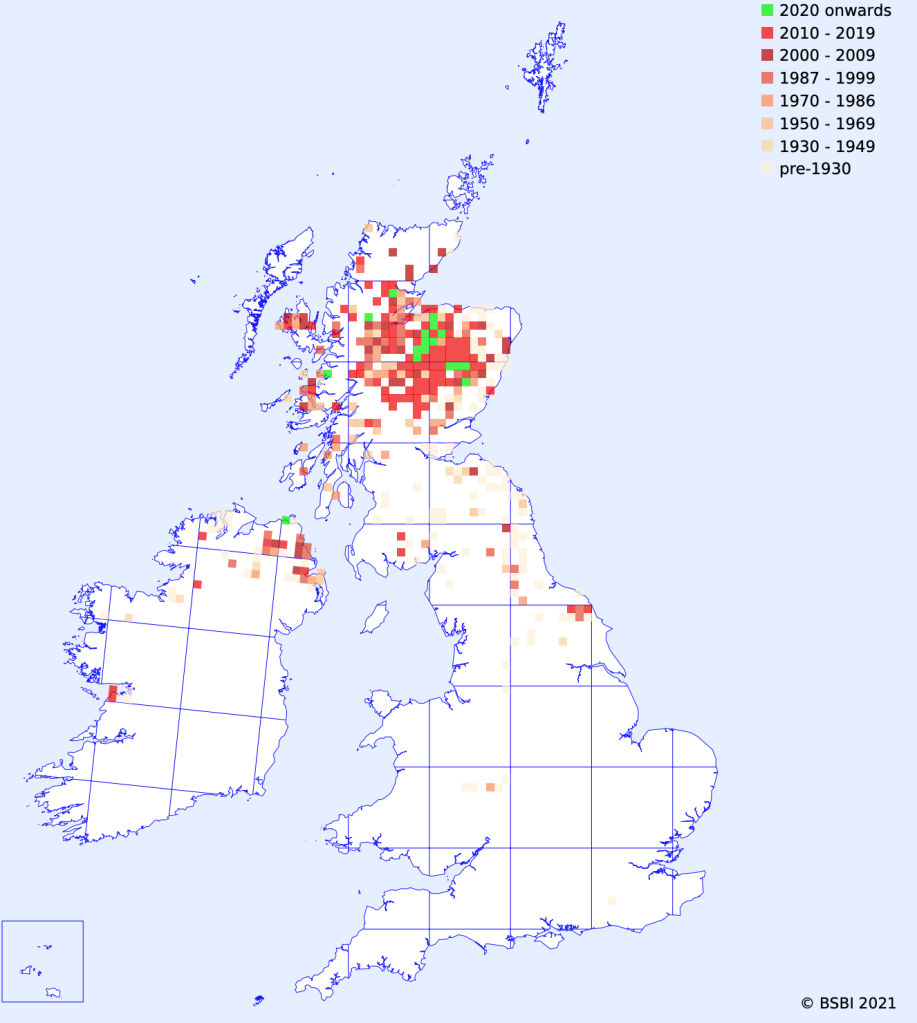Pyrola media is a member of the heather family (Ericaceae). It has sometimes been attributed to the Pyrolaceae, but this would now usually be regarded as a sub-family within the Ericaceae. It may have originated as a hybrid derived from other wintergreen species including Pyrola minor (Common Wintergreen). It has twice the number of chromosomes of the other Pyrola species. Its chloroplast DNA is very similar to P. minor, but the nuclear DNA comes from a different plant in the genus.

Pyrola media is a low perennial herb with a rhizomatous growth form. It is evergreen, which can sometimes be a useful feature when seeking locations, as many plants do not flower regularly in Scotland.
The leaves have long petioles and are in the form of a basal rosette. The flowering stem can be up to 30 cm tall and the white flowers are arranged round the stem in a terminal raceme. The flowers have as straight style of between 4 mm and 6 mm, projecting just beyond the flower, an important identification feature.
It flowers between June and August, with many plants not producing flowers every year. It usually leaves persistent dead heads.
Pyrola media is often to be found in the ground flora of pinewoods, although it can sometimes be in heath habitats in association with Calluna vulgaris (Heather) and other small herbs. These may sometimes be the sites of former pinewoods. I have sometimes seen it on the edges of steep gorges. It may be found from low to intermediate altitude levels, although I have usually found it at slightly higher altitudes than the commoner Pyrola minor (Common Wintergreen).
In the UK it is regarded as nationally scarce, being found in fewer than 100 hectads (10km Squares). Pyrola media is also classified as Vulnerable in the Red Data Book (Cheffings and Farrell 2005). Most of its sites are in Scotland, although there are a few scattered populations in England. In Scotland it is mainly northern and eastern, being especially widespread in the Cairngorms. It is also to be found in other parts of Northern Europe.


There has been evidence of decline in recent decades, perhaps because of changes in land management. This is difficult to assess, however, as there have sometimes been identification difficulties. In recent years new sites have come to light, although some of these may have always been present but eluded observation.
When in flower, the three British Pyrola species can be distinguished by the length and shape of the style. The style of Pyrola media is 4-6 mm long, projects beyond the flower and is straight. The style of the more widespread Pyrola minor, which may also occur in pinewoods, is only 1-2 mm and does not project beyond the flower. Caution must be exercised as the style of P. minor may appear to be longer when the petals have dropped.
Pyrola rotundifolia also has a long style of 4-10 mm but it is clearly curved. Care must be taken as I have seen the styles of dead heads of P. media appear to develop a curve. P. rotundifolia is scarce and may be coastal or in mountain locations.

Vegetative identification can give a guide but may not produce a definite answer. My late wife and I studied 75 leaves of 5 populations each of Pyrola minor and Pyrola media and 24 leaves from one population of P. rotundifolia. We also studied leaves from one site of Moneses uniflora (One-flowered Wintergreen) and two sites of Orthilia secunda (Serrated Wintergreen). Counting the small teeth in the leaves of the 3 Pyrola species showed that P. media leaves had more than 15 teeth in only 13% of the sample and P minor had more than 15 teeth in more than 91% of the sample. Our one population of P. rotundifolia had more than 15 teeth in 92% of the sample, but examination of herbarium specimens suggested that the Aberdeenshire P. rotundifolia population we used was probably not typical. Jane Squirrel of the Royal Botanic Garden Edinburgh kindly confirmed our identifications using DNA techniques. Pyrola media leaves also have longer petioles than Pyrola minor on average, if a number of leaves are examined.

Another Scottish wintergreen species is Serrated Wintergreen (Orthilia secunda), which is quite distinct, having a one-sided inflorescence. The very rare Moneses uniflora has solitary white flowers.
The plant called Chickweed Wintergreen (Trientalis europaea) is quite different, being in the Primulaceae and it is not wintergreen.
References:
Ballinger B.R. and Ballinger C.B. (2009) “Vegetative Identification of Wintergreens” BSBI Scottish Newsletter 31 19-20.
Cheffings C. M. and Farrell L. (2005) “The Vascular Plant Red Data list for Great Britain” JNCC, Peterborough.
Stewart A., Pearman D. A. and Preston C. D. eds. (1994) “Scarce Plants in Britain” JNCC Peterborough.
Brian Ballinger